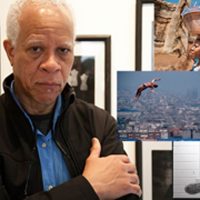Lou Jones: Trading Physics for Photography

Editor’s Note: This video interview is part of The Esther Paster & Rick Grossman ArtSpeak Photography Series.
LOU JONES’ eclectic career has evolved from commercial to the personal. It has spanned every format, film type, artistic movement and technological change. He maintains a studio in Boston, Massachusetts and has photographed for Fortune 500 corporations, international companies and local small businesses including Federal Express, Nike and the Barr Foundation; completed assignments for magazines and publishers all over the world such as Time/Life, National Geographic, and Paris Match; initiated long term projects on the civil wars in Central America, death row, Olympics Games and pregnancy; and published multiple books.
Jones has served on the boards of directors of numerous photographic associations, societies, and museums such as the American Society of Media Photographers, Photographic Resource Center and the Griffin Museum of Photography. He helped found the school Center for Digital Imaging Arts of Boston University and conceived the prestigious Griffin Museum’s annual Focus Awards.
For his photography, Jones has been awarded many accolades from organizations like Communication Arts Magazine, Art Directors Club of Boston, Travel Photographer of the Year and International Photographic Council (United Nations). Nikon recognizes Jones as a “Legend Behind the Lens” and Lowepro has honored him as a “Champion.”
Jones has exhibited his eclectic imagery in colleges and schools such as Trinity College, Texas Tech University and New England College, and in collections at the Smithsonian Institution, DeCordova Museum and the African American Museum in Philadelphia. His photography is owned by various collections including the Fogg Museum, Wellesley College and the University of Texas.
In addition, Jones lectures and teaches workshops all over the world, including at the PhotoPlus Expo in New York City, the Ford Hall Forum at Suffolk University, New England Camera Club Council’s annual conference, and Estúdio Brasil in Sao Paulo, Brazil.
The first book Jones published, Final Exposure: Portraits from Death Row, earned Jones the Ehrmann Award from Massachusetts Citizens Against the Death Penalty. Since then, he has published numerous other books including Travel+Photography:Off the Charts, and Speedlights and Speedlites: Creative Flash Photography at Lightspeed.
The videos below are organized by topic and run between 50 seconds and 14 minutes. Click on any video. You must be connected to the Internet to view the videos.
INSIGHT & INSPIRATION: 3:36 min.
EXPOSURE TO BROAD INFLUENCES: 1:46 min.
UNDERSTANDS ARTISTS’ NEEDS: 1:40 min.
OPEN TO CHANGE, FLEXIBILITY: 1:32 min.
PERSEVERANCE FURTHERS: 0:58 sec.
SEIZES OPPORTUNITIES: 4:31 min.
INSIGHT & INSPIRATION: 2:12 min.
CREATIVE FLEXIBILITY: 1:37 min.
UNDERSTANDS THE BUSINESS OF ART: 3:17 min.
SELF-CONFIDENCE: 2:17 min.
OVERCOMES CHALLENGES TO SUCCEED: 0:50 sec.
SERENDIPITY: 7:27 min.
DEVELOP A VOICE: 5:06 min
UNDERSTANDS THE BUSINESS OF ART: 13:41 min.
EXPOSURE TO BROAD INFLUENCES: 1:52 min.
COMMUNITY VALUES: 2:44 min.
EXPOSURE TO BROAD INFLUENCES: 4:32 min.
CRITICAL THINKING: 5:58 min
UNDERSTANDS THE BUSINESS OF ART: 1:58 min.
CREATIVE FLEXIBILITY: 2:22 min.
OVERCOMES CHALLENGES TO SUCCEED: 4:10 min.

